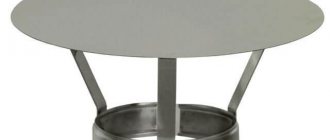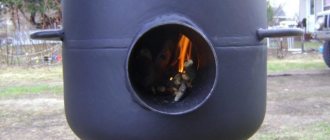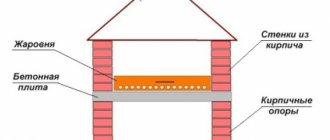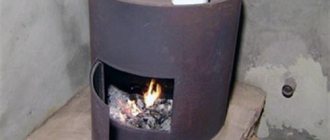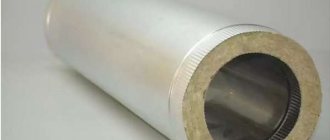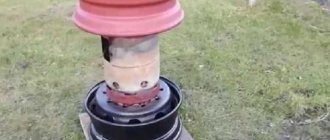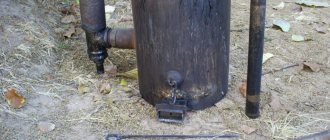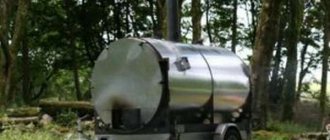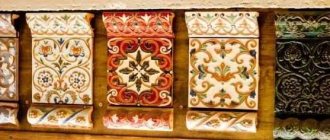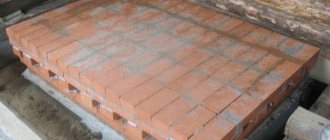What is good about a stove made from rims?
A small furnace made from rims
A furnace made from rims is advantageous because the material for its manufacture is easy to find. Car wheels are made of special steels of great thickness, which are not very susceptible to corrosion. The thickness of the metal plays an important role in the operation of any furnace. The increased thickness of the material prevents the structure from deforming under the influence of high temperatures. A stove made from car wheels works on any solid fuel, even coal, which has a very high combustion temperature. Thick metal accumulates heat better, although it is inferior in inertness to cast iron and cools somewhat faster.
The discs have a special design - the end part with holes. This structural element is suitable for organizing a burner, reduces the rate of heat loss, and is used for making a homemade grate. The outer rim of the disk is made with a nonlinear surface - this helps to increase the heat transfer area and optimizes the movement of flue gases when used to construct a smoke channel. Unlike cast iron stoves, a steel disk stove has the highest impact strength and is not afraid of water getting on hot surfaces.
The main criteria that speak about the advantages of a DIY disk oven:
- Availability of manufacturing materials;
- High strength, reliability;
- Favorable configuration of a single element - a car disk;
- Long service life;
- Ease of manufacture;
- Fuel versatility.
What kind of stoves can be made from car rims?
At the moment, home craftsmen have invented several types of iron stoves assembled from wheel rims. They can be divided by areas of application:
- heating;
- baths;
- for cooking, including barbecue.
These car parts are attractive primarily due to the thickness of the metal. The body of a wood-burning stove made of a steel disk will not burn out very quickly, especially if you take a wheel from a truck. The latter, as a rule, are used for the manufacture of sauna stoves, since they are large in size and metal thick. For a sauna stove, which often operates in extreme conditions, this is an important factor.
Discs from cars and commercial vehicles can make either a good wood-burning heater for the garage or a small barbecue stove. Let's look at them all in order.
List of materials and equipment for installation
Large-diameter steel reinforcement
To make a furnace from disks, you will first need the car wheels themselves. It is best to use wheels from cars and light trucks. Furnaces made from the disks of large heavy-duty trucks will turn out to be unnecessarily bulky and heavy, and it is difficult to ensure the tightness of their connections. For independent installation and assembly you will need the following materials:
- Large diameter steel reinforcement;
- Metal corner;
- Material for making gratings;
- Sheet of metal for mounting the door;
- Small pieces of metal for stops;
- Pipe with a wall thickness of at least 5 mm and a diameter of 100 mm;
- Steel pipe with a wall thickness of 2.5 mm and a diameter of 80 - 100 mm.
Steel reinforcement is used to make the legs of a garden stove; the legs are also mounted from angle steel. The metal corner is used as a base for laying skewers; it is often removable. To lay skewers, you can place the corners on the upper socket of the disk perpendicular to the skewers. The steel grate is used for barbecuing, grilling, and serves as the basis for installing a boiler or cauldron. The grating is made of steel reinforcement.
Disk ovens are often made with a door. To do this, you will need a sheet of metal, door hinges, or an improvised loop of nuts and bolts of different diameters. The presence of a door increases the safety of the stove and improves the combustion process.
The stops along the perimeter serve as the basis for installing the cauldron and firmly fix the removable grate. A thick-walled pipe with a diameter of more than 100 mm is useful for making a sauna stove from disks. A pipe with a diameter of 80 mm and a wall thickness will be required for installing a chimney for a garden stove.
To make the unit yourself, you will need the following tools:
- Welding machine;
- Welder mask, electrodes;
- If available - cylinders with a gas cutter;
- Angle grinder (grinder) with cutting and cleaning discs;
- Sledgehammer;
- Hammer;
- Measuring and marking tools - chalk, pencil, marker and tape measure.
It is more convenient to use a gas cutter for cutting metal - the discs have convex, rounded surfaces; processing them with a grinder will be difficult. A window cut by a gas burner is easier to remove carbon deposits with a grinder and a grinding wheel. A sledgehammer is useful for straightening badly bent car rims.
Assembling a potbelly stove from disks
The assembly of the housing is carried out on the basis of the drawn up drawing.
For convenience and support, it is necessary to weld the legs
Sequence of work:
- Remove the central parts protruding inward from the workpieces.
- Make two circles with the size of disks from an iron plate.
- Cut rectangular holes in the rings for the firebox and ash pan.
- Attach stops for the grate using a corner.
- Fix the disks together and weld them along the edges.
- Connect paired fragments together. You will get a pipe with curved walls.
- Weld a round plate to the bottom of the body. Grind off any metal protruding from the edges.
- Make a hole for the pipe on the top circle. Install a pipe on it that is smaller than the diameter of the chimney.
- Weld the top plate.
Finally, the grate is laid, the body is cleaned of scale and metal splashes, sharp corners are rounded, and polished for priming and painting.
Doors, legs, exhaust pipe
Handles, latches and legs are made from reinforcement and iron sheets remaining after cutting. It is better to take factory-made hinges and attach them to the body and doors with bolts. This is justified by the fact that welding may cause the products to become deformed. The legs should be attached to the frame from the corner, and it should be welded to the bottom of the fireplace. The pipe is placed on the pipe and then secured to the wall with clamps. The joints are sealed with asbestos cord or bandage.
Fire safety rules when installing homemade stoves
Compliance with fire safety rules is the most important aspect when operating and manufacturing homemade stoves. This equally applies to factory-made stoves.
The surfaces of ovens are very hot - this can cause ignition of flammable substances. As for disk stoves, they do not have an ash pan; ash with particles of hot coals can spill through the grate. To collect them, it is necessary to install a container of appropriate diameter to prevent the entrainment of hot particles.
An important factor is the presence of a firebox door. A closed door slows down the combustion rate of the fuel load and prevents the escape of hot particles and sparks.
When building a sauna stove from disks or a sauna stove, combustible building structures must be located at a safe distance from hot surfaces and shielded with a layer of fireproof material. Fireproof material must have a low thermal conductivity coefficient. The location of the stove in the garden or country house is not recommended near combustible structures and materials.
It is better to choose a free space without strong wind load for the installation location. This will prevent the spread of sparks in the event of firewood falling out or the stove falling. You cannot construct furnaces from disks to operate on waste oil or in long-term combustion mode. The properties of special steel are such that complete sealing of a welded joint can only be checked using special methods and non-destructive testing equipment. The presence of leaks will result in the leakage of highly toxic components of the burning oil or the release of smoke and carbon monoxide, which are hazardous to human health.
Barbecue oven
This wonderful device is made from two rims from passenger car wheels. Although, if someone wants a bigger stove, then there are no restrictions: you can use wheels from a UAZ or GAZ-53. One of them has the bottom carefully cut out and then the rims are welded together.
In order for the unit to be securely installed on any surface, the legs are welded to the lower section, as shown in the photo. By the way, the hole for the hub must also be plugged, but the side holes can be left, air will flow through them into the firebox. To make it easier to carry, handles are welded to the outside of the body, and an opening for the door is cut in the side.
The latter is made from the same piece, mounted on hinges. That's it, the oven made from car rims for barbecuing and cooking is ready. As practice shows, it can accommodate 5 skewers with meat.
Advice. There is no need to throw away the cut-off bottom of the upper disk; it can serve as a stand for a small saucepan, kettle or frying pan.
On the other side of the door, a pipe for the chimney should be welded; a diameter of 50-70 mm is sufficient. The tiles can be modernized a little, since when working, ash spills out through the lower holes, this is not very pleasant. The holes must be plugged, and the air flow must be regulated by the firebox door. Details about the stove are shown in the video:
How to make a stove from discs for a sauna with your own hands
Making a stove from disks
Metal disks on sauna stoves serve as a superstructure on a stone stove. They perform the following tasks:
- Serve as a surface for heat transfer into the bathhouse;
- They are the basis for the construction of a heater;
- Serve as a chimney trunk;
- On their basis, a water heating circuit is often constructed - a tank is installed.
Installing the furnace itself from metal discs is impractical. Smoke leaks may occur due to leaks in welding seams; the metal has low inertia and cools quickly.
The superstructure installation process consists of the following steps:
- The first disk is installed on the finished stone stove. The disk is installed with the free side down. The joints with the surface of the furnace are sealed.
- The second disk is installed on the front side of the first disk, and they are welded together.
- A hole is cut in the center of the front sides folded together, corresponding to the diameter of the selected chimney pipe. A pipe is installed on the cut hole and welded hermetically.
- A stone selection is placed in the internal space of the second disk around the pipe - it will serve as a heater. The stones are very inert and retain heat for a long time. They receive heat from heated metal disks, heat up and, when poured with water, produce steam.
- 4 posts of equal length are welded around the perimeter of the second disk.
- A third automobile disk is installed on the racks, face down, and a chimney is passed through it.
- The third disk is welded to the chimney pipe.
- Homemade tanks with a hole in the central part for the passage of a chimney are often installed on top of the disk. The water is heated in the tanks.
- The passage of the hot part of the chimney pipe through building structures is sealed with fireproof materials.
- A damper or gate is installed at the top of the chimney to regulate the draft force.
Sometimes stoves for baths using car rims are built according to a simplified design. A stove is installed on the surface of the firebox, and an open tank is placed on it to heat water. Next, behind the stove, channels are laid on the smoke channel instead of the upper wall. The channel joints are sealed with clay. A heater is laid on top of the channels.
After the heater, a vertical complex is constructed from disks welded together. The complex serves as a chimney channel and works as a heating device, releasing heat into the room. This design is much more reliable and airtight; it does not require the construction of an intricately shaped water tank with a passage space.
Stove made of disks for heating utility rooms
A disc stove for a bath differs from other heating structures in that it has a special water container and a brick base. If you only need to heat a room (for example, a small country house or a garage), the design will be much simpler. For the base of such a stove, you can install several refractory bricks or a section from old radiators, on which a sheet of metal 5-8 mm thick is installed.
The simplest design of a homemade stove made from wheel disks is done like this:
- Using a grinder, the central part of three of the four disks is cut out.
- Two disks are welded together. In the lower one, the bottom is covered with a round plate cut from a steel sheet, or immediately welded to a metal base.
Blank for the lower chamber
- A small square hole is cut on the side surface with a grinder, and a door is made from the resulting piece of metal. It can be attached to the body with welded bolts and nuts, equipped with an iron handle and latch. This part of the body will simultaneously serve as an ash pan and a blower - to increase traction, just slightly open the door of the lower chamber.
Fire door
- The two remaining disks are also welded together so that the whole disk with the uncut core is at the bottom - this is where the firewood will be stacked. A hole is also cut out on the side of the firebox and a door is mounted.
- The top of the stove is covered with a plate in which a round hole is made for the chimney pipe.
- All parts of the body are connected by welding, a pipe with a valve at the top is lowered into the upper hole and welded.
- The finished stove can be painted using heat-resistant enamel.
Ready oven for heating
Important! Seams are the weak point of any oven made from wheel rims. They must be welded with the utmost care, otherwise the smoke will penetrate into the room through the cracks, instead of completely escaping into the chimney. If the seams become thinner and burn out during operation of the stove, the cracks can be covered with clay and sprinkled with dry sand.
Step-by-step guide to making a wheeled stove
Assembling a stove structure from wheel rims is an activity that does not require special training, but does require skills in working with a welding machine. Before you get started, you need to decide on the type of device. It could be a stove, barbecue or potbelly stove. The furnace manufacturing process consists of several stages. The very first thing is to prepare materials and equipment.
List of materials and tools
The main components of the furnace are car wheels. The most suitable are steel rims from passenger cars or small trucks. Large specimens left over from large-tonnage trucks require efforts to seal the joints, and ovens made from disks of this size are cumbersome. For work you also need to prepare the following materials:
- wheel rims – 4 pcs.;
- Sheet steel;
- fittings;
- door hinges;
- square pipes;
- thermal paint.
To cut and connect parts you will need a grinder, a hacksaw (for fine cutting), a welding machine, a drill, a file, pliers, a tape measure, a hammer, and sandpaper. Brushes will be needed for painting.
First stage: preparing disks
All irregularities and dents on the rims are corrected - the shape should be symmetrical. The surface is cleaned of rust. If there is old paint, then the disk sources are calcined and sanded. But the most important thing is that car wheels must have smooth, even edges. This will ensure that the circles are in close contact and that there are no gaps through which smoke can penetrate. To level each disc, it is ground in a circle.
One disk out of four is left in its original state; it will be needed for the hob. The remaining three copies require additional processing. They cut out the core using a grinder. The result should be a hollow, wide pipe. When these three components are combined, the furnace body is formed.
Second stage: making grate bars
The grate is a lattice plate that separates the firebox and the ash compartment. Firewood or coal is placed on the grate, and the air coming from below provides draft and promotes their combustion. The easiest way to make grate bars is from reinforcing bars. They are cut into pieces and welded inside one of the disks. It is not necessary to make a lattice; it is enough to weld the rods parallel to each other.
Instead of reinforcement, you can use a sheet of steel. Slots are cut in it or holes are made. The steel must be thick enough to withstand the high temperature. A thin sheet will quickly burn out and will not cope with its function.
Third stage: welding parts
For welding work, 5 mm electrodes are chosen. The blanks are welded circumferentially to each other. The auto disk with the whole core should be the top one. First, the edges are pinched by welding. Then, making sure that the cylinder is smooth, weld along the entire edge. The result is a barrel-like structure. If necessary, the number of ring segments can be reduced or increased.
A circle is cut out of a steel sheet. If you plan to use the stove indoors, then this sheet should be larger in diameter so that the coals fall on it and not on the floor. If the stove will operate exclusively outdoors, the bottom can be the same size as the body. Four legs are cut out of a small diameter pipe and welded to the base of the stove.
Fourth stage: installation of a firebox and blower
The next step is the combustion and ventilation windows. The height of the firebox is determined at your discretion, but most often it is made in the second disk from the bottom. The blower is located under the firebox (in the lowest rim). The hole for it is smaller than for the firebox. The marked rectangles are cut out with a grinder. Frames for the holes are made from steel plates and welded. Doors are cut out of metal sheet and hung on hinges welded to the wall of the body. Handles are attached to the doors.
There is a simpler option for installing a firebox and a vent - without using frames. Rectangles cut from the cylinder barrel are used as doors. The hinges are welded directly to the body of the disk stove.
Fifth stage: painting
The finished structure is painted to give an aesthetic appearance. To do this, first all welds are processed with a grinding machine. The remaining areas with rust are also cleaned. After this, the body is coated with heat-resistant paint. Another option is to use a can of high-temperature paint. After the paint has dried, the oven made from car rims is ready for use.
Disc furnace assembly video
The entire process of making a stove from car wheels is shown step by step in the video:
